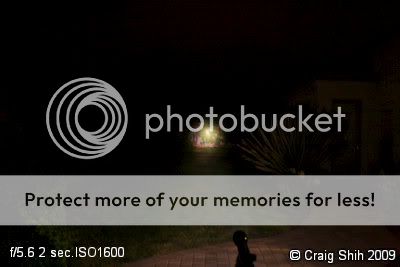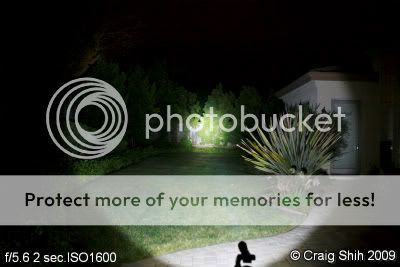entoptics
Enlightened
- Joined
- Oct 1, 2009
- Messages
- 386
Review of...
MagCharger vs 3D Maglite vs EagleTac T20C2 vs 2XAA Mini Maglite vs NiteCore D10 vs iTP EOS A3
I've compared my collection, so casual flashlight users can get a quick and simple demonstration of how "old faithful" technology is getting crushed by the new kids on the block in terms of efficiency.
The lights for this review (click any thumbnails for full size images in a new window)...

Some info on the "exotic" lights.
MagCharger ($90) - ~8 years old and well used. Original NiCd battery pack.
EagleTac T20C2 ($50 on sale) Warm tint LED, Smooth Reflector. A newer, brighter version is available (MKII @ ~$90). Runs on either 2 x CR123 batteries, or 18650 Li-ion rechargeable. 15% brighter with CR123s, but runtime is half that of 18650. 3 output modes (High, med, low) + strobe.
NiteCore D10 Tribute Edition ($65) - Runs on single AA or 14500 Li-ion rechargeable. Brightness is exactly the same, but Li-ion has ~50% longer runtime. 2.5 ounces with battery. 2 quick access output modes (High and ultra low) and infinitely variable brightness ramp between.
iTP EOS A3 ($20) - Runs on single AAA. 3 modes (head twisty). 0.8 ounces with battery.
All beam-shots are taken with my Nikon D5000, 18 mm lens, f 9.0, ISO 800 (shutter speeds are next to thumbnails). Each flashlight had absolutely freshly charged batteries, EXCEPT those for the 3D-cell maglight, which are regular alkalines at approximately 75% charge. NiteCore D10 and EagleTac T20C2 are running Li-ion rechargeables. EOS A3 and Mini-Mag are running NiMH rechargeables.
The first image is a reasonable approximation of what the hallway looked like in real life, and the Maglite beams are all defocused to show their short range illumination capabilities. The other thumbnails with faster shutter speeds have the Maglite beams focused to give a better idea of long range performance and throw. Autobots and Decepticons included for scale.
Exp = 1/2 sec Exp = 1/8 sec
Exp = 1/8 sec  Exp = 1/30 sec
Exp = 1/30 sec 
The thing that is immediately obvious is the insane potency of the small Cree LED lights. The T20C2 is considerably more powerful than the MagCharger (especially at longer distances) and the little EOS A3 keychain light dominates the 3D-Maglite. The NiteCore D10 is only a hair less powerful than the MagCharger, yet it is 1/10th the size. The Mini-Mag basically didn't even make it to the game...
Secondly, the beam quality of the LED lights trounces the Maglites (and most other common incandescents). Smooth spill beams with a perfectly circular hotspot. Even the T20C2, with its smooth reflector for long throw has a pretty smooth spill with only minor rings.
Finally, what really sets the LEDs apart from the MagLites? Run times and output profiles... All run times below are "approximations" from gleaning manufacturer stats, CPF reviews, and Flashlightreviews.com.
All three Maglites have runtimes of ~1 hour to 50% output. More importantly, they have a sharp decline in brightness for the first 10 minutes (down to ~70% brightness), then steadily decline from there on. The LED lights have an initial slight drop, but then have a relatively steady output (~95% brightness) until they dramatically fall off to <10% brightness. This means that the time to 50% numbers listed below are weighted in favor of the Maglites over the LEDs, because the MagLites put off less light integrated over that time and their brightness at any given point in the run cycle is not nearly that of fresh batteries.
Run Times on Max.
Maglites ~1hr to 50%
EagleTac T20C2 (18650 Li-Ion) ~3 hrs to 50%
NiteCore D10 (14500 Li-Ion) ~1.3 hrs to 50%
iTP EOS A3 (NiMh AAA) ~1 hr to 50%
Comparing apples to apples...For the small lights, here are some beamshots at similar output levels. Note the run times.

At the same weight and length as the Mini-Mag, the T20C2 will only last a measly 7.5 days on low power (slightly brighter than MiniMag for 180x as long). The EOS A3 will run on medium mode (considerably brighter than Mini-Mag) for 3.5 hours, and it's 1/3 the size. I've left out the NiteCore D10 from this comparison because it has an infinitely variable "medium", so it would be impossible to directly compare run times unless I was to measure them myself at similar light levels. Suffice to say, it's about double the potency of the EOS A3, so I'm guessing it would put out Mini-Mag light levels for at least 10-15 hours.
on low power (slightly brighter than MiniMag for 180x as long). The EOS A3 will run on medium mode (considerably brighter than Mini-Mag) for 3.5 hours, and it's 1/3 the size. I've left out the NiteCore D10 from this comparison because it has an infinitely variable "medium", so it would be impossible to directly compare run times unless I was to measure them myself at similar light levels. Suffice to say, it's about double the potency of the EOS A3, so I'm guessing it would put out Mini-Mag light levels for at least 10-15 hours.
It should also be noted that all three LED lights reviewed here are hard anodized aluminum, with O-ring seals and glass lenses. These lights will withstand at least as much abuse as any Maglite, and probably considerably more due to incandescent bulb failure.
Hope this enlightened (yuk! yuk!) those of you who are curious how old tech stacks up against new tech in the "real" world.
MagCharger vs 3D Maglite vs EagleTac T20C2 vs 2XAA Mini Maglite vs NiteCore D10 vs iTP EOS A3
I've compared my collection, so casual flashlight users can get a quick and simple demonstration of how "old faithful" technology is getting crushed by the new kids on the block in terms of efficiency.
The lights for this review (click any thumbnails for full size images in a new window)...

Some info on the "exotic" lights.
MagCharger ($90) - ~8 years old and well used. Original NiCd battery pack.
EagleTac T20C2 ($50 on sale) Warm tint LED, Smooth Reflector. A newer, brighter version is available (MKII @ ~$90). Runs on either 2 x CR123 batteries, or 18650 Li-ion rechargeable. 15% brighter with CR123s, but runtime is half that of 18650. 3 output modes (High, med, low) + strobe.
NiteCore D10 Tribute Edition ($65) - Runs on single AA or 14500 Li-ion rechargeable. Brightness is exactly the same, but Li-ion has ~50% longer runtime. 2.5 ounces with battery. 2 quick access output modes (High and ultra low) and infinitely variable brightness ramp between.
iTP EOS A3 ($20) - Runs on single AAA. 3 modes (head twisty). 0.8 ounces with battery.
All beam-shots are taken with my Nikon D5000, 18 mm lens, f 9.0, ISO 800 (shutter speeds are next to thumbnails). Each flashlight had absolutely freshly charged batteries, EXCEPT those for the 3D-cell maglight, which are regular alkalines at approximately 75% charge. NiteCore D10 and EagleTac T20C2 are running Li-ion rechargeables. EOS A3 and Mini-Mag are running NiMH rechargeables.
The first image is a reasonable approximation of what the hallway looked like in real life, and the Maglite beams are all defocused to show their short range illumination capabilities. The other thumbnails with faster shutter speeds have the Maglite beams focused to give a better idea of long range performance and throw. Autobots and Decepticons included for scale.
Exp = 1/2 sec
 Exp = 1/8 sec
Exp = 1/8 sec  Exp = 1/30 sec
Exp = 1/30 sec 
The thing that is immediately obvious is the insane potency of the small Cree LED lights. The T20C2 is considerably more powerful than the MagCharger (especially at longer distances) and the little EOS A3 keychain light dominates the 3D-Maglite. The NiteCore D10 is only a hair less powerful than the MagCharger, yet it is 1/10th the size. The Mini-Mag basically didn't even make it to the game...
Secondly, the beam quality of the LED lights trounces the Maglites (and most other common incandescents). Smooth spill beams with a perfectly circular hotspot. Even the T20C2, with its smooth reflector for long throw has a pretty smooth spill with only minor rings.
Finally, what really sets the LEDs apart from the MagLites? Run times and output profiles... All run times below are "approximations" from gleaning manufacturer stats, CPF reviews, and Flashlightreviews.com.
All three Maglites have runtimes of ~1 hour to 50% output. More importantly, they have a sharp decline in brightness for the first 10 minutes (down to ~70% brightness), then steadily decline from there on. The LED lights have an initial slight drop, but then have a relatively steady output (~95% brightness) until they dramatically fall off to <10% brightness. This means that the time to 50% numbers listed below are weighted in favor of the Maglites over the LEDs, because the MagLites put off less light integrated over that time and their brightness at any given point in the run cycle is not nearly that of fresh batteries.
Run Times on Max.
Maglites ~1hr to 50%
EagleTac T20C2 (18650 Li-Ion) ~3 hrs to 50%
NiteCore D10 (14500 Li-Ion) ~1.3 hrs to 50%
iTP EOS A3 (NiMh AAA) ~1 hr to 50%
Comparing apples to apples...For the small lights, here are some beamshots at similar output levels. Note the run times.

At the same weight and length as the Mini-Mag, the T20C2 will only last a measly 7.5 days
It should also be noted that all three LED lights reviewed here are hard anodized aluminum, with O-ring seals and glass lenses. These lights will withstand at least as much abuse as any Maglite, and probably considerably more due to incandescent bulb failure.
Hope this enlightened (yuk! yuk!) those of you who are curious how old tech stacks up against new tech in the "real" world.
Last edited:













